Gemini schedule reliability falls below 90% target for the first time
The Gemini Alliance has dropped below its targeted 90% reliability for the first time since ...

Dachser has launched an expedited China-US less-than-containerload (LCL) service to help shippers cope with the chronic congestion at west coast ports.
Demand for LCL has been on the rise since the start of the Covid crisis, with shippers and forwarders hoping to avoid premium airfreight rates, or simply find space in a market increasingly devoid of containers.
Dachser has combined LCL cargo with priority unloading, to reduce average container dwell times at the ports of Los Angeles and Long Beach (LA-LB) from 14-25 ...
Transpacific sees first major MSC blanks as rates fall and volumes falter
'It’s healthy competition' Maersk tells forwarders bidding for same business
Opposition builds for final hearing on US plan to tax Chinese box ship calls
White House confirms automotive tariffs – 'a disaster for the industry'
New price hikes may slow ocean spot rate slide – but for how long?
Supply chain delays expected after earthquake hits Myanmar
Good start for Gemini, liner schedule reliability data reveals
Shippers snap up airfreight capacity to US ahead of tariff deadline

Comment on this article